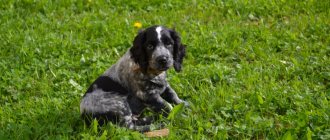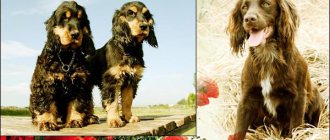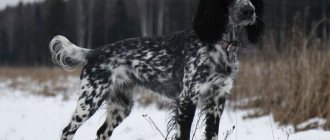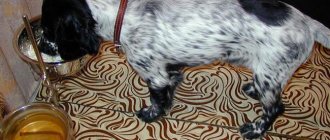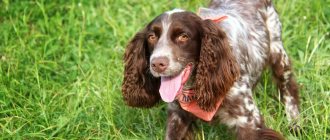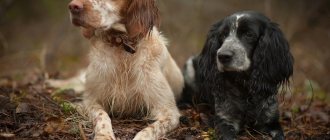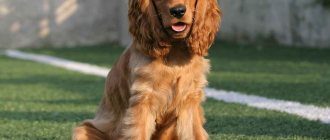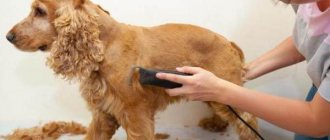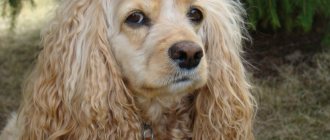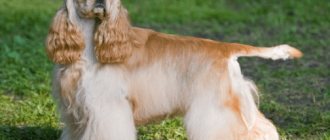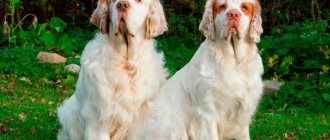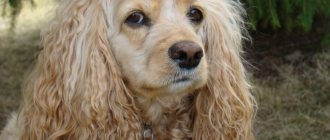Representatives of the breed are not suitable for a mixed diet. They can only be given a certain set of products or high-quality ready-made food.
In order not to harm the puppy, you should take into account other recommendations from veterinarians and experienced dog handlers regarding feeding spaniels.
Origin of the breed
In the 19th century, the favorite pastime of the Russian tsars was hunting; fabulous amounts of money were spent on the selection and maintenance of hunting dogs. Working hunting dogs were presented as expensive gifts from European monarchs to the rulers of Russian lands. With the advent of the English Cocker Spaniel in Russia, connoisseurs of elite hunting have become increasingly interested in game birds. But the short-legged, aristocratic English dog could not move with sufficient speed through the weeds and ravines of central Russia.
Interesting! The history of the breed is rooted in the creation of the English Cocker Spaniel breed, the Springer Spaniel and the desire of hunters to obtain a universal working dog for game birds.
By crossing various spaniels (mainly English and Springer), it was possible to obtain a relatively uniform dog. Purposeful breeding work began in 1927 in St. Petersburg. In 1945, Moscow became interested in the new species, and a club for breed lovers appeared. In 1949, intensive work began on developing a new domestic breed - the Russian hunting spaniel. The official birthday of the breed is 1951, the first standard was drawn up and a stud book was opened. Since 1972, the Russian Spaniel has completely stopped mixing genetic codes of other breeds.
Interesting! The Russian Hunting Spaniel is not recognized by the International Canine Federation.
Factors influencing growth
Height and weight gain of cocker spaniels depend on a number of factors:
- Heredity. This means not only a genetic predisposition to specific diseases, congenital pathologies, but also the parameters of ancestors. Large parents are more likely to produce large offspring than miniature representatives of the breed.
- Conditions for keeping a mother dog during pregnancy and her offspring. A pregnant dog or puppies need a calm, cozy, quiet and warm place without drafts, high humidity, or noise. Stress from unfavorable living conditions can affect the development of animals. Factors such as time of year, climate, and environmental conditions also have their influence.
- Balance, calorie content of the mother’s diet, timely introduction of complementary foods for the offspring. A pregnant dog should receive increased portions of high-calorie food on a strict schedule - it is best to stick to the menu compiled by the veterinarian. Do not forget to introduce complementary foods to puppies on time - first liquid, and then solid. Monitor their reaction to new food.
- Portion size, harmony of diet components, frequency of meals. Consult your veterinarian about your little spaniel's diet.
- Physical exercise. A growing organism must constantly move, run, play and frolic in order to develop harmoniously. However, exhausting activities and activity after a full lunch, on the contrary, harm the cubs.
Related breeds
The closest relatives of the Russian spaniel are the American and English cocker spaniels, but the difference between them is not only in color and coat type, but also in hunting instincts and constitution.
English cocker spaniel
The domestic spaniel differs from the English cocker in the shape of the skull and body. The Russian has longer legs and a more extended format. The English spaniel is more squat and stocky. Visually, the ROS looks small and light, but is not inferior in endurance and performance. The English “relatives” are not so willing to fetch game from the water, but they are not inferior in flair and thirst for hunting.
American Cocker Spaniel
The American Cocker Spaniel has a more aristocratic appearance compared to its prototypes, with clear lines of the head and back, and more abundant hair. He is inferior in height and weight, although he is just as active and hardy. Working American Cockers can be practically counted on one hand due to their aesthetic beauty. Increasingly, Americans meet at exhibitions rather than hunting.
Key points in training
When training an English Cocker Spaniel, any use of violence is excluded. Only clear instructions from the owner about what the dog is doing wrong. It is allowed to spray water and throw an object towards the cocker.
- The breed is distinguished by its excellent memory. The owner will not need to repeat commands multiple times. It is not permissible to ignore commands during training.
- The English Cocker Spaniel loves to eat, so training with encouragement (a piece of cheese, a carrot) is considered acceptable.
- The owner determines the rules of behavior for the pet in the home. Habits need to be developed from a young age. The dog is smart, remembers well, habits will form quickly.
Training is divided into stages:
- The educational part is carried out at 3 months of age. Experienced dog breeders conduct training on their own; beginners can turn to instructors. Education is carried out in the apartment and on the street.
- It is recommended to start obedience training for the owner at 6 months.
- The general training course begins at 8 months. At this point, you need to determine what skills to develop. If the pet is a future hunter, use special training and methods for speed, endurance, and focus on prey.
Read about how to properly train a dog in the article: “Training a puppy: effective methods from dog handlers, learning commands at home.”
Dimensions of a lounger, booth, house or enclosure
Cocker spaniels are medium-sized pets. This determines the size of the bed, booth, house or enclosure.
Standards for the listed equipment for the breed:
• mats, rugs, beds, cribs – M or L; • booths, houses – rarely used, since the dog is a decorative breed, the size is determined taking into account the pet’s height; • cells – average dimensions are 75 by 53 by 60; • aviary – free space is achieved on an area of 1.2 by 1.2 m.
Cocker spaniels are a medium-sized breed, which is reflected in the selection of clothes, shoes, collars, and other items. It is advisable for the owner to know how the dog develops according to the norms in order to track whether the pet is growing correctly. Height and weight values indicate the health status of the animal.
How to measure a Cocker Spaniel correctly
To determine the weight, you should put your pet on a regular scale and record the result. To determine the height, you will need to learn how to correctly measure a cocker spaniel.
Recommendations and main measures:
- neck circumference - measurement is taken at the widest part, where the collar is usually located;
- the length of the dorsal part is from the beginning of the neck to the base of the tail;
- Chest circumference - measured at the widest point, usually behind the forelegs.
To ensure correct measurements, you will need to position your pet exactly. The back must be measured in a standing position along the spine. The dog should not stand or lie down.
Description and breed standard
A brief description of the breed is presented in the table:
| Short description | |
| Origin | Russia |
| Conditions of detention | Private house or apartment |
| Purpose | Hunting, gun, companion |
| Color | Solid, bicolor piebald, tricolor, with tan |
| Wool length | Middle length |
| Adult dog size | Height 36–44 cm, weight up to 20 kg |
| average life expectancy | 12–15 years |
| Walk | Mandatory, from 2 times a day |
| Need for physical activity | High demand - from 2 hours a day |
| Classification of the International Canine Federation (FIC) | Not recognized by the IFF |
| Puppy cost | From 5 thousand rubles to 20 thousand, depending on the pedigree and working qualities of the parents |
Description of parameters:
- General form. A compact, squat dog with a slightly stretched format. Strong, with good muscles.
- Head. Relative to the small size of the body, the transition from the forehead to the muzzle is pronounced, but not strongly, the occipital protuberance is weakly expressed. Scissor bite, full set of 42 teeth. The ears are hanging, located at eye level or slightly higher, the length of the ear reaches the nose. The eyes are symmetrically located, dark brown in color, not too prominent. The nose and rims of the eyelids are ideally black; in red colours, pigmentation to match the color of the coat is allowed. The lips are dry, fit tightly to the jaw, jowls cover the lower jaw.
- Neck. Set relatively low, with slight dewlap, strong, with well-developed muscles.
- Frame. Stretched format (stretch index - 110–120%). The chest is wide and deep, reaching to the elbow joint. The back is straight, the withers are well defined, the loin is short and muscular. The croup is quite sloping.
- Limbs. Straight, strong, parallel to each other, with good articulation angles. The hind legs are very muscular, the toes are arched. Pasterns without markings. The length of the front legs is equal to half the height at the withers.
- Tail. Located on the line of the back, held no higher than its level. In working dogs it stops after the fourth vertebra.
- Sexual dimorphism is pronounced. Its presence is encouraged, but females of the male type are not disqualified.
Congenital characteristics for disqualifying a dog:
- too large or small in height (dwarf) and weight of the stated standard;
- too aggressive;
- shorthaired or mongrel haired;
- solid white color;
- presence of malocclusion;
- mixed breeds with other spaniel groups;
- erect or short ears.
Coat and color
The guard coat of the Russian Spaniel is of medium length and coarse, lying close to the body, slightly wavy, but without curls. Longer on the stomach, ears, and paws than throughout the entire body. There is practically no undercoat. Due to the lack of undercoat and tight-fitting outer coat, the dog looks almost smooth-haired.
There are three varieties of colors:
- solid;
- two-color;
- tricolor.
Solid color can be: black, red, brown (chocolate). With all solid colors, white markings on the chest, paws, and tail are acceptable. Red can be any shade - from golden to reddish.
There are two-color ones: black and white, red and white, brown and white. Two-tone colors are also called piebald or harlequin.
Tri-color colors include solid black or brown with white markings and red tan, or piebald with black and tan markings on a white background.
Weight and height
The preferred height at the withers for males is 40 centimeters (+-2 cm), for females - 38 centimeters (+-2 cm). An adult male ideally should not weigh more than 20 kilograms, a female - more than 17.
It is important to know! Height and weight parameters are relative. The main thing is that the dog looks organic for its size and does not have excess weight. The exterior can only be fully assessed on a fully formed individual. Russian spaniels grow until they are 18 months old.
General information
This type of ammunition is more comfortable and safe for the pet, since a sudden jerk does not injure the muscles and vertebrae of the neck.
IMPORTANT! Some dog breeds have a larger neck circumference than their head circumference, so a classic collar is contraindicated for them in order to avoid injury to the lymph nodes and disruption of blood supply. For such animals, a harness is indispensable! How to choose the right harness for your dog
How to choose the right harness for your dog
Before you buy a harness, you need to understand what it is suitable for. The choice of harness depends on its intended purpose.
Types of harnesses:
- Walking. The leash ring is attached to the withers, the design is simple, intended for everyday walks.
- Walking with a handle. Suitable for large breeds, as well as weakened or injured animals. The handle allows you to reduce the dog's load by transferring part of its weight to the owner. Can be equipped with additional straps for attaching to various types of vests.
- Harness-vest. An ideal solution for smooth-haired dogs of medium-sized or decorative breeds.
- Riding harness. Used in harness. Indispensable for training dogs participating in sledding competitions. They differ in design, the fastenings for the harness are located on the sides, are equipped with additional soft pads in places where they fit most closely to the body, and are made of especially durable synthetic materials.
- Harness with weights. Equipped with a large number of pockets of various sizes for placing cargo in them. This is, in fact, a sports equipment, a simulator for weightlifting dogs. Helps to form sculpted muscles in the animal and develop a classic exhibition stance. The design of the harness is such that the weights are placed comfortably and evenly, without putting pressure on the back and chest. It may also have side rings for attaching, for example, tires to drag it across the sand.
- Car harness. Designed for safe and comfortable transportation of dogs in the car. At the moment, the market offers 10 options for special harnesses that have fastenings similar to seat belts for people. Their range is wide enough to choose a harness for any breed of dog.
- Harness for a puppy. When purchasing, you need to try it on carefully and take into account the further growth of the dog. Such a harness should have straps for additional adjustment to fit the size.
Important! For puppies of large and medium breeds up to 10-11 months, a harness is generally not recommended, as it can damage fragile bones and joints. Puppies of small and decorative breeds can wear a harness from 6 months
So, you have decided which harness to choose for your dog, now let’s look at the nuances that need to be taken into account when purchasing.
The harness must be made of high-quality, wear-resistant materials. It is easy to care for, wash and wash if necessary. The harness has enough fasteners to allow you to adjust the size if necessary. The tight fit to the body is such that the animal does not feel discomfort, but at the same time cannot throw off the harness. Also, nothing should restrict the dog’s movements. Size
It is important to buy the first harness after trying it on. Yes, you can try to choose the right one using size tables and a centimeter, but it’s still better to have a specialist show you how to properly put the harness on your dog and how to adjust all the parts to fit.
If you decide to buy a dog harness in an online store, it means that all previous recommendations for choosing have been taken into account; the only question left open is how to choose a harness without trying on.
Breed characteristics
The Spaniel's personality is suitable for any person. Representatives of the breed get along well in families with children and single people, with experienced or novice hunters. Not suitable only for lazy people - the spaniel is too energetic.
He has a lively, playful disposition and behaves like a puppy until old age. Ready to follow the owner with its tail, wanting to attract attention. At the same time, it lends itself well to training and has remarkable endurance. Not prone to dominance, gets along well in a pack of several dogs.
It has excellent innate hunting qualities. Easily learns to retrieve ducks from the water and search for wounded birds. You can train to follow a blood trail, follow a hare, or even use a dog for fishing. The spaniel is more obedient than the husky, but is no less comfortable and hardy in hunting. It will not be difficult even for a novice hunter to develop a ROS into a universal hunting assistant.
Despite the versatility of the spaniel, we must not forget that, first of all, it is a gun dog. Its true purpose is to lift the bird on its wing. But the breed allows you to choose who to hunt.
Weight by month
To determine whether your baby is eating and weighing correctly for his age, you should familiarize yourself with the recommended life period and body weight:
- 1 – 1.7 kg;
- 2 – 3.8 kg;
- 3 – 6.2 kg;
- 4 – 8.3 kg;
- 5 – 10.5 kg;
- 6 – 11.5 kg;
- Year – 14-15 kg.
Do not forget that this is an organism with characteristic physiological inclinations and characteristics; deviations from the norm are possible by no more than 1.5 kg. In your situation, 3 kg is normal.
Character traits
This dog, an achievement of Russian breeders, is distinguished by its friendliness and cheerful, cheerful disposition. The pet becomes attached to its owner and is capable of becoming a reliable hunting assistant and faithful companion. He gets along well with other pets, especially if they grew up together from childhood. However, small pets like rats or hamsters may be considered prey and a hunt may be launched for them, which will sooner or later end in victory.
Distinctive characteristics of the breed, which some owners lovingly call “spaniel”:
- endurance;
- energy;
- excellent hunting sense;
- remarkable intelligence;
- persistence.
The spaniel is able to find and drive prey and bring it to its owner. She loves to swim, so she easily helps in catching waterfowl, primarily ducks. However, proper attention should be paid to raising a pet from the age of a puppy. The owner can have fun. Watching the baby's funny antics, but if you give him free rein, a stable habit will form. But it is impossible to retrain an adult dog.
The animal adores the children of its owner, plays with them with pleasure, has fun, but can show aggression towards strangers and especially unfamiliar children. Therefore, on the street, it is important to ensure that no one tries to pet the dog.
Features of character and behavior
The English Cocker Spaniel is a cheerful, playful, good-natured dog. They adapt well to a large family and get along well with single people. However, only one person will be considered the real master and obey unquestioningly. The nature of a getter, strong muscles, and a strong sense of smell of a dog of this breed will also appeal to lovers of hunting and an active lifestyle.
Advantages
The advantages of the English Cocker Spaniel are:
- Beauty . The stately and impressive Briton will not go unnoticed while walking around the park.
- Intelligence – the dog understands human language well, which makes it easy to train.
- Developed intelligence and hunting disposition allows the spaniel to independently make important decisions in the shortest possible time.
- Friendly attitude towards children . Active games in the fresh air attract the dog; the spaniel will happily chase and frolic with the children. Parental vigilance still does not hurt, especially if the child is under 7 years old.
Flaws
The disadvantages include negative points:
- Pets are strongly attached to their owner , sometimes allowing them to show feelings of ownership and jealousy.
- Stubbornness is a characteristic trait of the breed. A calm explanation of the rules and training from an early age will help the owner raise an obedient pet.
- Some individuals are prone to long barking. Observation and consultation with a veterinarian will help the breeder rule out mental abnormalities.
Maintenance and care
Spaniels are not suitable for keeping in a kennel; the lack of undercoat does not allow them to feel good outside all winter. The ideal housing option is a private house, but with appropriate walking, you can keep a Russian hunter even in a small apartment.
Walks
Spaniels are very active dogs with a strong hunting instinct. They can cause trouble within the city, because they love to chase pigeons and other birds not suitable for hunting. This behavior must be stopped by methodically raising the dog, showing it the boundaries of what is permitted.
For long walks outside in winter or in very bad weather, it is recommended to use special protective clothing: raincoats and overalls for dogs. It is not advisable to toilet train at home - the animal is too active, and without a long walk it can exhibit destructive behavior.
Combing and cutting
The absence of a thick undercoat allows you to do without grueling daily combing. But dead guard hair needs to be removed about once a week. During the molting period - 2-3 times in 7 days. You need to use a fine-tooth comb or a furminator.
Working dogs receive exclusively hygienic haircuts. The hair is trimmed between the paw pads and around the anus. In order for the dog not to freeze while hunting, there is no need to cut it anymore, although after running through weeds and bushes, the appearance of the coat will have to be brought back to normal.
Cleaning ears and teeth
The ears and teeth of a completely healthy dog do not cause much trouble. You can take care of your teeth using special toothpastes and brushes designed for pets. Cleaning at home should be done no more than 2 times a month. Pets with dental problems tend to develop tartar every week. It is recommended to have the mouth examined by a veterinary dentist twice a year.
A healthy spaniel's ears do not require special attention. Cleaning can be done as the ear gets dirty (1-2 times a month), but you need to constantly monitor the condition of your ears. Working dogs are prone to infection with ixodid and ear mites, which lead to inflammatory processes in the body.
Antiparasitic treatment
Treatment for ectoparasites and helminths is very important for working spaniels. The hunting season coincides with the time of active hunting of the ixodid tick and it is not difficult to become infected with worms in the wild.
Preventive treatments against helminths are carried out at least once every 3 months. If the dog is infested, the procedure must be repeated after 10–14 days. It is more expedient to treat animals living in a flock at the same time.
Prevention of ectoparasites is carried out according to the instructions of the selected method. The choice of antiparasitic drug is up to the dog owner, depending on the pet’s individual tolerance and the owner’s financial capabilities. Each product has its own pros and cons, and it is up to the owner to decide which one to use.
Socialization
American cockers are obedient and easy to train. For full development, you should alternate physical and mental exercises. Spaniels are trained in a playful way, excluding any violence. As a result of the use of brute force, animals become isolated and cease to obey the owner.
Socialization of a spaniel puppy begins as early as possible - from about 8 weeks. He is introduced to his relatives and other people, taught not to be afraid of strangers. At 4 months of age, the American Cocker may try to dominate. This behavior must be stopped immediately.
Properly socialized spaniels do not clash with other pets. Only in relation to birds can they show a hunting instinct. Cockers develop very close friendships with cats.
The spaniel and the children quickly find a common language. They enjoy spending time together. The American Cocker is tolerant even of children and calmly tolerates their pranks.
Breed diseases
The Russian Hunting Spaniel is a healthy breed, but there is a tendency for some diseases. Among them:
- otitis;
- obesity (prone to overeating);
- allergy;
- lacrimation.
By knowing breed predispositions, all diseases can be prevented. To do this, it is enough to monitor the quality, volume and diet, condition of the ears and eyes.
How long Russian spaniels live depends directly on their state of health. The average life expectancy is 12–15 years.
Vaccinations
Immunization of domestic animals against rabies is required by law. Vaccinations against all other viral infections are done at the discretion of the owner. But for working dogs, vaccination is a necessary procedure, since wild animals are carriers of viral diseases, including rabies.
Important! Veterinary institutions have the right to refuse admission if the dog is without a muzzle, no matter how kind it may be.
When to get the first and subsequent vaccinations, what types of viruses there are - find out from the table
| Age | Diseases | Notes |
| 6 – 10 weeks | Parvovirus enteritisLeptospirosisCarnivore plagueInfectious hepatitis | First vaccination |
| 10 – 14 weeks | Parvovirus enteritisLeptospirosisCarnivore plagueInfectious hepatitis | Revaccination |
| 10 – 14 weeks | Rabies | The first immunization, if the puppy is kept in a greenhouse, can be postponed until the change of teeth |
| 10–12 months | Parvovirus enteritisLeptospirosisCarnivore plagueInfectious hepatitis | Last puppy vaccination, repeated every year |
| 10 – 12 months | Rabies | Last puppy vaccination, repeated every year |
Adult dogs are vaccinated once a year, often using a complex vaccine against rabies and other common viruses. Before each immunization, it is necessary to carry out helminth prophylaxis.
Hygiene procedures
You can wash your puppy’s paws and belly with water after every walk, and bathe him with shampoo weekly.
The standard procedure includes cleansing the coat and skin with shampoo and moisturizing the coat with conditioner. The water should be warm, but not hot
After each wash, dry the dog's coat thoroughly, paying special attention to the ears.
When washing your puppy, be careful not to get water in the ears - this can cause otitis media.
Constant brushing of the coat will prevent the formation of tangles.
Particular attention should be paid to the areas behind the ears, armpits, and groin. The Cocker Spaniel is groomed 4-5 times a year.
To do this, you can contact a groomer - a dog hairdresser, or learn how to cut your hair yourself.
In addition to the breed's haircut, once every 10-14 days, the puppy's ears are cleaned, his nails are trimmed, and the fur on his paw pads is trimmed. To clean the ears, apply lotion to a cotton pad and carefully wipe the entire visible space of the ear.
To clean teeth, use dog pastes and brushes or special chewing bones and treats. If the plaque on your pet's teeth is too pronounced, it is recommended to consult a veterinarian.
Nutrition for puppies and adult dogs
Regardless of the owner’s decision on what to feed his dog, natural or dry food, it is necessary to follow the feeding regime. Adults, whatever the breed, need to be fed no more than 2 times a day.
It is difficult to choose a complete diet, rich in all the substances necessary for health, on your own. Therefore, many owners increasingly prefer industrial ready-made food.
Puppies' diet by month:
- Newborns - 1 month. The mother of the puppies monitors the feeding regime.
- 2 months. The breeder begins to feed the babies 2-4 times a day, depending on the number of puppies and the bitch’s ability to feed them.
- 3–4 months. Puppies are fed small portions every 3 hours, 6 times a day.
- 4–6 months. The interval between feedings and portion size are increased, food is given 4 times a day.
- 6–10 months. Teenagers are served breakfast, lunch and dinner.
- 10–12 months. You can gradually approach the regime of an adult dog - 2 times a day.
Clothes and shoe sizes for Cocker Spaniels
Cocker Spaniel clothing and shoe sizes vary depending on the pet store. However, general notations are accepted.
- Shoe size is determined in centimeters along the length from the heel to the claw line. In stores, shoes should be selected according to the length obtained.
- Clothes are measured using 3 measurements: chest and neck circumference, back length. The standard size for cocker spaniels is L. To make clothing loose, it is allowed to add 2-3 cm to the chest circumference.
Reviews
Nikolay, Ekaterinburg
“When I bought a cocker spaniel, I asked the breeders what kind of food the puppy’s parents eat. They said Royal Canin. I also started feeding my baby these super premium granules. The dog grew up strong and beautiful. Then I switched him to adult dog food.”
Nadezhda, Pervouralsk
“I wanted to feed my spaniel natural products. But this is very expensive and troublesome. At about seven months I switched the baby to ProPlan food and was not mistaken. And the puppy felt good, and I had more free time. Now I can take him on long walks.”
What should a spaniel puppy weigh? Experts' answer
The health of a growing organism is associated with living conditions and, of course, with diet. The food of spaniel puppies must be varied and correct, otherwise it will have unpleasant consequences. The weight of a Spaniel puppy largely depends on your care, so you should pay close attention to this issue. Find out what to feed babies, how to correctly calculate monthly portions and what you need to know about dog nutrition.
How to choose a puppy
Before you go for a puppy, you need to study its pedigree and talk with the breeder about the working instincts of the parents. Breeders and nursery owners are willing to make contact with the future owners of their charges. If you travel far, you can ask to send a photo or video of both parents and the babies themselves to assess their condition. An obvious breed defect is noticeable even in photographs.
You should not buy puppies from dogs whose breed is in doubt, or if they are kept in poor conditions (on a chain, in a kennel on the street). It is impossible to predict how developed the hunting instinct is in such individuals. Parents who are kept in terrible conditions often have a huge number of genetic and acquired diseases. Caring for a puppy from such breeders can be expensive, troublesome, and ultimately futile.
Basic principles of nutrition
Caring for a spaniel puppy is a demanding job, and you need to understand that it is serious business.
Once your puppy is weaned and has teeth, you must teach him to eat solid food. Ideally, a baby should start eating this kind of food from the age of two months.
And the owner has two feeding options:
- natural food that you and I eat;
- professional dry food.
If, for example, a puppy changes home and owner, then you must gradually accustom him to your food system so that the pet does not develop an upset stomach.
Prohibited Products
A balanced menu means feeding your dog healthy foods while excluding prohibited foods.
The list includes:
- raw cabbage;
- millet cereal;
- semi-finished products;
- avocado;
- spices, pickles, smoked, fatty foods;
- bones of rabbits and chickens;
- pork;
- river fish and any types of raw fish;
- mushrooms.
Onions and garlic are conditionally prohibited foods - they can be given occasionally. In addition, cold and hot food, as well as food prepared from expired ingredients, are harmful.
If you follow these rules, then raising a healthy, cheerful and active dog is very simple. Another important condition is sufficient attention to the pet.
Breeding
An important characteristic when breeding individuals is the health of the future parents. Before mating two dogs, make sure that they do not have any hereditary diseases. The most favorable age for mating is 2 years. Although puberty occurs earlier, it is still recommended to wait to make sure your pets are healthy. The bitch's estrus lasts 71-127 days. It is “visible” to the human eye that occurs in 21-32 days.
The animal's gestation period lasts about 58 days. The average number of puppies is 5. However, even with such a small number, not all survive.
During and after childbirth, a sudden drop in the mother's temperature may occur. Enlist the help of a veterinarian to ensure the process goes smoothly. If your pet is taking too long to give birth, the puppy may be stuck and the birth canal is narrow. Therefore, it is better to enlist the help of your veterinarian in advance.
Nicknames for Russian Spaniel
The choice of a nickname for a working dog should be primarily aimed not at aesthetics, but at how the dog will remember it and respond to it. The nickname should be clear, short, and sonorous. You should avoid words that are difficult to pronounce or too long - it may be difficult to call when hunting.
For boys
Suitable names for spaniel boys:
- Robie;
- Roy;
- Rudy;
- Barney;
- Raf;
- Oscar;
- Roni;
- Kai;
- Kevin;
- Radar;
- Noah;
- Ren;
- Eric;
- Hoshi.
For girls
Suitable nicknames for girls spaniels:
- Molly;
- Dolly;
- Lucky;
- Laura;
- Dory;
- Nika;
- Mary;
- Boni;
- Lika;
- Sparta;
- Bullet;
- Puma;
- Us;
- Whiskey.
Periods of puppy development
Growth chart for Alabai puppies
The development of cubs is divided into four large periods - neonatal, transitional, socialization and juvenile. At each of them, important physiological and behavioral changes occur.
Neonatal
The period lasts from birth to 2 weeks:
- 1-3 days. Newborn puppies are completely dependent on their mother and are absolutely helpless. The main thing for them is to get enough milk.
- 5-7 days. The cubs are not yet able to defecate, but their ears begin to open and their noses become colored. They distinguish the smell of the mother, the taste of milk, feel heat and cold.
- 8-10 days. Puppies double their weight, react to heat, begin to squeak and whine in response to stimuli.
- 10-15 day. Their eyes open, but the babies still see poorly, which does not prevent them from learning to crawl.
During this period, it is important for the owner and breeder to provide a cozy “nest” - to protect the mother and cubs from noise and drafts, to maintain optimal air temperature and room illumination. Photos and videos of newborn English Cocker Spaniel puppies:
Photos and videos of newborn English Cocker Spaniel puppies:
https://youtube.com/watch?v=aHf0-GiwvAM
Transition
A short but important stage of development (2-3 weeks):
- 16-17 days. The hearing organs begin to function - the puppies distinguish where interesting sounds are coming from and crawl towards them. They know how to stand on their paws and imitate their mother’s behavior.
- 18-20 days. Along with the appearance of adipose tissue, thermoregulation develops. Puppies react to stimuli and develop a defensive reflex.
- 21-24 days. The kitten hears and sees perfectly, its body temperature is regulated. Teeth begin to erupt. The kids play among themselves, with their mother, and learn to wag their tails.
The owner gets to know the kids and gives them the opportunity to explore the house. Offers soft complementary foods and carries out first deworming.
Photos and videos of English Cocker Spaniel puppies 1 month:
Photo of a black puppy:
Socialization
Quite a long period (3-12 weeks):
- 24-28 days. Meat becomes more interesting than milk. The mother teaches the puppies to interact with the world, drink water, eat, bite.
- 30-35 day. A one-month-old puppy is no longer tied to its “den.” The cubs begin to erupt with fangs and false teeth. They begin to respond to the nickname - it’s time to learn the first commands and move on to initial training.
- 45-55 day. The nervous system of the kitten is formed. He actively explores the world and learns new commands.
- 8-9 weeks. “Period of fear” - the baby must be protected from everything that can frighten him. The animal is finally transferred to solid food. At this time, it is easiest to accustom the kitten to the toilet.
- 2 months. The baby is given the first vaccination. His baby teeth are fully formed. Puppies sleep less, play most of the day - hunting, defense, pursuit, attack. The dog is already able to control the force of the bite - during this period the person sets the boundaries of what is permitted for the kitten.
- 3 months. Carrying out the second vaccination. The Cocker Spaniel can be taken for walks on a leash.
By the end of the socialization period, the puppy knows how to communicate with animals and people, understands “dos” and “don’ts,” and knows simple commands.
Photos and videos of English Cocker Spaniel puppies 2 months:
Photos and videos of English Cocker Spaniel puppies 3 months:
Juvenile
The longest stage is from 12 weeks to puberty. Along with it, the active development of the young dog slows down:
12-16 weeks. An animal in search of its position in the “pack”
It is important for the owner to firmly, but without violence, show the dog his place, and not allow him to dominate people. 6-8 months. Baby teeth are completely replaced by permanent teeth
Girls begin their first heat - the puppy period ends. The weight of a cocker spaniel is 80% of the weight of an adult.
At 10-12 months, the physiological development of the dog stops. His behavioral attitudes and habits are also fully formed.
Photos and videos of a 4 month old English Cocker Spaniel puppy:
Photos and videos of an English Cocker Spaniel 5 months:
Photo of an 8 month old English Cocker Spaniel puppy:
Photo of an English Cocker Spaniel 12 months:
Learning ability
In terms of learning ability, the “star” character can again play a cruel joke. The Cocker must be constantly praised, but scolding is prohibited. The dog will understand the reproachful tone, but will simply demonstratively not react to the scream.
On the scale of intelligence and intelligence, a cocker deserves five points, but with reservations. We need to find an approach to this proud handsome man. He must be the best and the first in everything - the owner’s praise is the best incentive for training.
To punish a cocker, you don’t need to scold or shout at him, just ignore the dog. It’s not there for you, that’s all. Spaniels are very worried about their owner's inattention and will try to immediately correct their mistake, which caused your displeasure.
Attitude towards children and other family members
This is a lively, curious and cheerful dog who is happy when his owners are at home. He does not like to be left alone for a long time, so breeders advise keeping a pair of spaniels if you are at work for a long time.
The delicate and even overly neat cocker is smart and quick-witted, but with a trick - it’s difficult to refuse this loving, touching look a cookie, but it’s necessary.
The dog loves children very much and reacts calmly to pets. But there is a sincere hostility towards cats, which can take away part of the owner’s love. There will be a quiet but constant war with them in the house.
The disadvantage of Cocker Spaniels is some nervousness and fussiness. Therefore, always speak to your cocker in a gentle and calm manner. Violent manifestations of emotions can provoke a puddle on the parquet from an excess of feelings.
Education and training
Russian spaniels are diligent students, especially when it comes to learning how to hunt game. The innate desire to search for and raise a bird is so strong that special training is often not needed. With systematic training to find and retrieve birds, the spaniel will become a universal hunter.
How to train, how many commands to study - this must be decided by the owner from the moment the puppy arrives at home. You can train a spaniel in basic obedience at home, without the help of specialists.
It is important to know! The main thing is to be consistent, methodical, calm. Before starting training, you need to decide: what a dog needs to know in order to become comfortable and useful for the owner.
How to take measurements correctly
The height of the animal in the area of the withers is measured directly from the highest point between the shoulder blades to the end of the forelimb. Measurements are taken using a special ruler. If you don’t have a measuring device, you can make such a measuring ruler yourself.
There are rules for uniform measurements for all dog breeds. They are as follows:
- Each measurement must be carried out with a special instrument. Violation of this rule causes different results. Dimensions at the withers are taken by professionals using a special hard measuring stick. At home, dog breeders often use flexible tape or tape measure. This causes the difference in results to be of the order of 1.5 – 3.5 cm (when measured with a tailor’s meter, the height is greater).
- Measurements are taken several times, and the interval between measurements is 1-2 minutes. From the results obtained, an average number is isolated, which is considered the final measurement.
- When taking measurements, the animal must be in a special exhibition stand.
- The device for taking measurements should fit tightly to the animal’s body, pressing the fur. But pressing into the skin is not acceptable. In dog breeds with long hair, the hair is removed from the withers area.
The method of placing a flat object on the withers will help to correctly determine the highest point on the dog’s back. A book or any flat object should be positioned parallel to a hard surface. It is noteworthy that the growth of the animal undergoes changes if dogs of different breeds were bred when receiving the puppies. In dogs that do not have a breed, their growth can be large or, on the contrary, small. In purebred dogs, the height at the withers must correspond to the established breed standards.
Estrus, mating and pregnancy
Owners of females not intended for breeding are recommended to undergo complete castration before the first heat. This will save you from many problems during collective hunting and hormonal imbalances in the body. Owners of bitches with breeding value need to understand that during estrus and pregnancy the dog will fall out of heat.
Estrus occurs during puberty - from 6 to 11 months, depending on the characteristics of the body. Mating is allowed to be planned no earlier than the third heat or upon reaching the age of 18 months. The male is looked for in advance, and the female is taken to the male’s territory for mating on the 10th–15th day of estrus. A veterinarian can predict a good day for mating after examining a female dog in heat. Females remain pregnant for 56–64 days.
Health and illness
The English Cocker Spaniel has excellent immunity and good health, but, as the owners note, the health of these dogs deteriorates with age.
Potential diseases:
- otitis;
- urolithiasis disease;
- joint dysplasia;
- allergy;
- eye diseases;
- deafness;
- lipoma, melanoma;
- hepatitis;
- epilepsy;
- hydrocephalus.
Sometimes problems with the pet's psyche may arise. This is expressed by hysterical seizures, which can be treated with physical exercise and activity of the animal.
Owners of this breed are faced with the issue of mating and childbirth, which also affects the health of the pet.
Recommendations for breeding and giving birth to an English Cocker:
- The first heat in female dogs occurs between 12 and 18 months. However, it is not recommended to perform mating for the first time. Breeders advise waiting until the next heat, which will be in six months. The bitch must be bred on the 8th-10th day of estrus.
- Mating is a responsible undertaking. According to the rules, the dog must first undergo a full medical examination and receive a referral from the club for mating.
- Before breeding animals, you should get to know the owners themselves. The presence of the owners during copulation will calm the animals and ensure that the mating was successful.
- Pregnancy in cockers lasts 60-70 days. Please note that it will be possible for the dog to be in position only 10 days after mating. The bitch's nipples will swell and become more pink.
- Pregnant dogs require special care, so if the owners do not have experience in this matter, it is better to seek help from a veterinarian.
It must be remembered that childbirth is a rather complex process that takes away the strength and sometimes the health of the dog. Owners should be aware that it is not necessary to breed the bitch. It is necessary to sterilize a dog when there are signs of a false pregnancy or the pet has health problems.
Lifespan
On average, dogs of this breed live 10-14 years. The health of a pet is closely related to proper care for it. If you do everything correctly, visit the veterinarian on time, follow the instructions, you can extend the life of your pet. Don’t forget about vaccinations, because this is an important indicator of a dog’s well-being.
Vaccination recommendations:
- The first vaccination for a cocker spaniel is given at 8-9 weeks. 10 days before vaccination it is necessary to undergo deworming.
- The second vaccination is done 3-4 weeks after the first.
- The third vaccination is carried out at 1 year.
After vaccinations in the first year of life, vaccinations are carried out annually or according to special instructions from the veterinarian.
Water
In addition to a properly selected and balanced diet, the dog needs a sufficient amount of fluid, otherwise the risk of dehydration increases.
The main rules for watering a puppy:
- keeping the bowl freely available;
- cleanliness of the liquid;
- regular water renewal;
- compliance with the temperature regime – 20-25 degrees;
- systematic cleaning of dishes.
Dog trainers recommend choosing bottled or filtered water for your puppy. It is better to refuse boiled, raw is strictly prohibited.
What you should absolutely not give to dogs
All dog owners know how much their pets can beg for treats, but there are foods that should not be given to spaniels, even if you really want to:
- sugar and products containing it (yogurt with additives, chocolate and other harmful carbohydrates);
- popcorn, beer, spirits;
- avocado. It contains the toxin persin, which is contraindicated for most animals. In some countries this product is banned for dogs;
- grape. It can cause kidney failure;
- bread and dough tend to expand in the stomach and lead to irritation of the digestive tract.
Hunting with a Russian Spaniel
With the Russian Hunting Spaniel, hunting turns into an exciting sporting competition. This is the best gun dog - it does not leave the hunter, flawlessly carries out commands, and does not drive the game too far.
With a Russian Spaniel you can go hunting for any type of game birds or small furs. This breed is excellent for searching for wounded animals or holes, following a blood trail. ROS can not only lift a bird under a shot, but also bring it back to the hunter. It is noteworthy: spaniels get excited very quickly, and in this state they are ready to work in any weather conditions.
Interesting! At the end of the twentieth century, Russian spaniels were used to hunt even small ungulates.
Hunter reviews
Real reviews from owners:
- A very beautiful, kind and active dog. Even if you don’t go hunting with her, she forces you to walk a lot, and this is good for your health. Her husband always takes her with him, even on fishing trips, and never returns empty-handed.
- Excellent working qualities. Although the puppy was not taken from hunters, on his first trip to pick mushrooms, the little puppy “obtained” a mouse den - he smelled it and dug it up! After some training, we went with him to duck - he picks him up and pulls him out even from impassable reeds. I advise all bird hunters to get a Russian spaniel.
The best ingredients for a productive hunt are a Russian spaniel, a gun and a hunter.
Benefits of drops
Flea and tick medications in the form of drops are used more often than others. This is due to a number of their undeniable advantages:
High efficiency. As a rule, one treatment is enough to protect the animal from parasites for one or two months. In this case, the drug begins to act 20 minutes after application. You will notice this by the improvement in your cat's well-being. She will become more active, her appetite will increase; The drops are safe and, when used correctly, cannot harm the animal.
But at the same time, we should not forget about precautions; Convenient to use. Most often, the drops are packaged in a small pipette designed for one use.
With its help, you can apply the drug to a specific area of the skin; After using the product, the cat will not need to be bathed. You don’t have to wear an uncomfortable collar that your pet tries to take off.
Article on the topic: Flea drops for cats and kittens
Due to these advantages, drops are used more often than other means to combat parasites. Veterinarians recommend using them.
Types of feedings
First you need to understand the types of feeding for small cockers. The breed responds positively to all three standard feeding methods:
- ready-made dry mixtures;
- natural products;
- mixed type: dry food is supplemented with wet food, meat, cereals.
When preparing a diet, it is important to take into account the dog’s temperament.
There are adherents of each type of food; it all depends on the choice of the owner. However, the fundamental factor when choosing the type of feeding should be the character of the animal and the purposes for which the owner got the pet. For example:
- Sports dogs that are trained to participate in hunting, fishing, hiking, and sports should choose dry food. It must be of high quality. Such foods contain a lot of protein for muscle development, support of ligaments and the skeletal system, as well as carbohydrates, which provide energy. In addition, it is convenient to take dry food with you to feed your pet during training or fishing.
- “Sofa” pets can be given natural products - meat, soups, cereals. However, a veterinarian’s consultation is necessary here: perhaps the individual needs of the pet’s body require a more competently selected menu.
- It is recommended to give puppies natural foods. During growth, their digestive system must become stronger and learn to process hard fibers, and their teeth are renewed from careful chewing before switching to dry food.
Many spaniel owners opt for dry food
As a rule, most dog breeders choose convenient feeding with dry food. They are trying to get away from the mixed type for several reasons: it is uneconomical and problems arise in creating a complete diet. In addition, the dog’s body may not accept mixed food - to digest dry and natural food, different enzymes and absorption periods are needed.
How to train a dog to be carried
Before you go on your first trip, your dog should learn to sit (and stay) in his carrier. Dog handlers recommend taking the learning process seriously. By approaching the matter wisely, you can quickly accustom your pet to being carried and travel without problems.
To prevent your dog from panicking when space is limited - placed in a sling, backpack or carrier, you should:
- Introduce your pet to a new accessory. Do it in a playful way, give it time to get used to it.
- Do not use the carrier for punishment purposes. Do not lock your dog in a container if he is in the way or annoying.
- Do not leave your pet “in the cage” for a long time. Longer than 2-3 hours for a young dog and longer than 8 hours for an adult.
- In order for your pet to love its new “house,” follow the standard instructions. Sit with your dog in front of the crate, first stock up on your favorite treat. Place a piece at the entrance of the carrier and let your dog come and eat it.
- Each time, try to put the treat deeper into the “cage”. Praise and reward your pet if he moves forward and tries to go inside.
For your first walk in a carrier, go somewhere where your dog regularly goes for walks: a park, a pet supply store, or a friend's house... Just not the veterinarian! Bring plenty of treats with you to keep your pet occupied on the go.
Choose a carrier based on the size of your dog - large, medium or small. Focus on the area of use. You also need to take into account the pet’s desire, accustom him to such walks in advance and take care of safety. When purchasing a dog carrier, give preference to products from well-known and reputable manufacturers.
